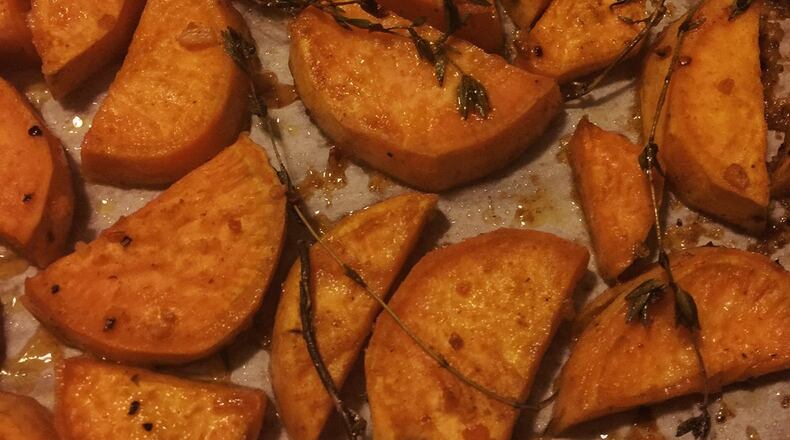As much as I love green bean casserole, the component of our American holiday dinner I regard the most as comfort food is candied sweet potatoes.
Part of the morning glory family of plants, sweet potatoes are native to tropical parts of the Western Hemisphere and their domestication goes back at least 5,000 years.
According to Stephanie Pappas’ Live Science article, “History of Plenty: How the Thanksgiving Meal Evolved,” the tradition of eating candied sweet potatoes originated in the West Indies when African slaves worked on sugarcane plantations. To grow their own food, slaves were given plots of land unsuitable for sugarcane, and highly-nutritious sweet potatoes were a favored crop.
Slaves who boiled sugarcane to make molasses would pour the hot liquid over raw sweet potatoes, thus cooking them. So what started as a staple food of slaves became Southern soul food, and from there spread out across America to become a popular holiday dish.
As cooks continue to tweak and experiment, our cuisine will continue to evolve and so will our holiday meal. The sweet potato recipe I’ve adopted this year comes from Marcus Samuelsson, owner of The Red Rooster restaurant in New York’s Harlem. He’s been a judge on Top Chef, Iron Chef, Chopped and The Taste, as well as a guest chef at the White House.
Born in Ethiopia, Samuelsson and his sister were separated from their father, an Ethiopian Orthodox Church priest, during that county’s civil war, and the children were adopted and raised in Sweden. Samuelsson then came to the United States and made Harlem his new home.
His twist on candied sweet potatoes is very easy, and the chipotle chile powder, thyme and garlic provide a sophisticated balance to the honey and potatoes’ natural sweetness. It’s considerably healthier than the saccharine marshmallow variety I grew up with. You can make the potatoes the day before, then take them out of the refrigerator and either serve at room temperature or heat up. They’d also work great for an office carry-in or open-house party.
GARLIC ‘N’ HONEY ROASTED SWEETS
2 pounds sweet potatoes, peeled and cut into 1/2-inch half moons
¼ cup olive oil
1 teaspoon coarse kosher salt
1 teaspoon chipotle chile powder
1 teaspoon ground cumin
2 sprigs thyme
4 garlic cloves, smashed
2 tablespoons unsalted butter, cut into pieces
2 tablespoons honey
1. Preheat the oven to 400 degrees Fahrenheit. Line a rimmed baking sheet with parchment.
2. Toss the sweet potatoes with the olive oil, salt, chipotle chile powder, cumin, thyme and garlic.
3. Spread the sweet potatoes out in a single layer on the baking sheet. Roast for 20 minutes. Stir, dot with the butter and drizzle on the honey. Roast until the sweets are caramelized and tender, another 20 minutes.
4. Lift up the parchment and slide the sweets into a serving dish. Serve warm.
From the book: "The Red Rooster Cookbook: The Story of Food and Hustle in Harlem" by Marcus Samuelsson; 384 pages, $37.50. Published by Houghton Mifflin Harcourt, 2016.
What you get: Interspersed inside a riveting and lyrical narrative of his insights into both Harlem and African American cuisine, Samuelsson organizes his recipes by days of the week and includes cocktails, brunch food, sides, meats and an entire chapter on chicken.
In his own words: "I offer the food I grew up with, big dishes that made you suck your fingers. Good lumpy gravy with odd-shaped kroppkaka, Swedish potato dumpling. But my food also comes out of church cooking, home cooking, diners, and the Southern tradition of meat and three (side dishes). It's black culture, but it's for everyone." — Marcus Samuelsson
About the Author
